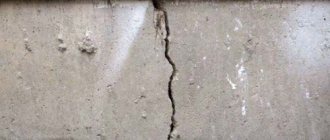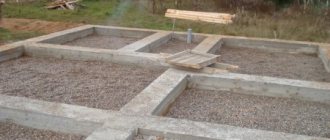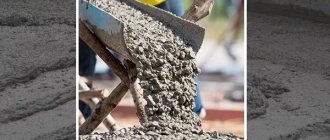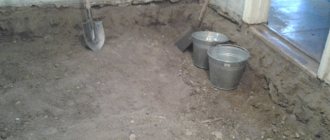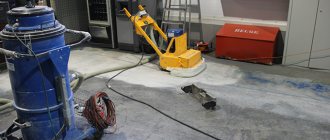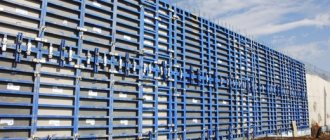Existing types of foundation
You can calculate the amount of material for the foundation yourself or use the services of a specialized design company. The entire process of laying the foundation, as well as its subsequent maintenance, must occur strictly in accordance with the requirements of the project, adhering to the proportions. There are several types of fundamental foundations, and they are divided according to the material used, as well as the installation method:
Rubble concrete foundation
- Rubble - its installation is distinguished by bandaging the seams with cement mortar;
- Rubble-concrete – installation is carried out by pouring concrete into wooden formwork;
- Reinforced concrete, concrete - such a structure can be either monolithic or prefabricated and can consist of several elements.
But it doesn’t matter what type of foundation is under the house, the main thing is that the care of the concrete after pouring must be of high quality. This is done to obtain a sole of increased reliability and strength, and to ensure that the erected building lasts as long as possible.
Before starting any construction, you need to familiarize yourself with all types of foundation structures:
- Tape - laid around the entire perimeter on the inside and outside of the wall.
- Solid - has the form of a monolithic slab of reinforced concrete and is intended for installation in places where the soil is too mobile.
- Columnar - placed either under free-standing supports or under a wall.
- Pile - the structure of the structure is installed on piles immersed in the ground and filled with concrete.
Each designed house has its own foundation, the type of which depends on the mass of the future building, the characteristics of the soil, the quality of the concrete mixture and the material that will be used.
Concrete work at high temperatures
On hot summer days, caring for concrete after pouring is especially important. SNiP (Building Norms and Rules) recommends during this period to lay concrete prepared with quick-hardening grades of cement. They begin to use it at temperatures above 25° C, while the value of the solution itself should not exceed 30-35° C.
Therefore, it is important to maintain the temperature of fresh concrete to 25° C. If cracks appear, the solution can be vibrated again, but no later than an hour after it is laid. After this, the concrete surface is covered with waterproofing material, which must be periodically moistened.
It is not allowed to pour water on open areas of a concrete structure, as sudden temperature changes will lead to destruction of the material. In this case, watering must be carried out only by spraying in order to prevent damage to the integrity of the top layer.
How to work with concrete correctly
Vibration compaction of concrete
The most important and troublesome moment is the moment of pouring the fundamental foundation of the building. Those people who are going to build a house with their own hands need to learn that any work with concrete consists of three components:
- The stage of preparing a concrete mixture.
- Pouring concrete mixture.
- Maintenance of fresh concrete.
These stages have a direct connection with each other. If you make the slightest, even insignificant mistake, you can forget about the strength and quality of the foundation under the structure. Therefore, each of the works included in the overall process of constructing a foundation must be performed by a specialist with certain skills, knowledge, and in compliance with the rules. In addition, you need to approach each stage with special responsibility. Only then will you get a reliable foundation that will not be subject to destruction or cracking during use.
Warming up concrete in winter
The main feature of caring for fresh concrete in winter is its heating. If this measure is not carried out, then as a result of the freezing of water in the solution and the expansion of ice crystals, pores are formed in the material, which reduce the strength of the structure. Today there are many heating methods:
- One of the oldest methods is the thermos method, which is based on the hydration effect. The well-heated solution is delivered to the site at the asphalt concrete plant, very quickly placed in formwork and covered with heat-insulating material. When water interacts with cement, heat will begin to be released. As a result of this process, by the time it freezes, the concrete will have time to gain critical strength.
- The use of antifreeze additives, subject to technology and certain rules, also makes it possible to ensure concrete strength gains. In this case, the formwork must be covered with waterproofing material to prevent precipitation from entering the concrete mixture.
- A particularly popular method of caring for the solution in winter is electric heating. It is usually carried out using electrodes of different shapes. After laying the concrete, electrical conductors are buried into it at a certain distance; usually, reinforcement pins are used. Then a connection is made through one or two electrodes using wires coming from a special step-down transformer. When the heating process begins, the electric current between the electrodes will pass through the liquid solution, which will begin to heat up and solidify. This method is also very often used using a reinforced formwork frame.
All these methods of care can be used either individually or in combination with each other.
Proper maintenance of concrete base
Freshly poured concrete
Freshly laid concrete needs special attention. This consists in creating a condition that will promote hydration of the solution. Simply - transforming it from a liquid or plastic mixture into a hardened stone made of cement. As a result of this process, the concrete will gain strength and strength. For this to happen, you need to wait almost a month. Some scientists have even proven that it takes much more time - about several years - for hardening to reach its peak, but the air temperature in the room should be 20-25 degrees, and a certain humidity is also required.
The pouring time directly affects the way it is cared for. Therefore, caring for concrete in the winter is the exact opposite of the rules for caring for the base in the summer. This must be remembered and applied, since the seasons of the year leave their mark on the quality and characteristics of the foundation.
How to care for concrete after pouring at different times of the year?
Water is an important component of the concrete mixture, which participates in the chemical reaction when the screed hardens. Therefore, caring for concrete after pouring is aimed at retaining moisture or constantly moistening the surface. The external environment determines the methods for maintaining the hardening process of the material. Therefore, it is not necessary to care for concrete after pouring in the same way in winter and summer. This takes into account the temperature and degree of air humidification.
Summer way to care for concrete
It is not recommended to deliver concrete mixture in the heat, so it is better to do it either early in the morning or in the evening, after the sun has set. The poured solution on a sunny day needs to be provided with additional protection. It is covered with roofing felt, slate sheets or other material suitable for this purpose.
Caring for concrete during rain is to prevent the solution from being washed away and holes from forming on the poured surface.
Clearly organized work throughout the concreting process is very important. When ordering ready-made concrete mortar from a construction company, make sure that its delivery to the construction site does not exceed 1 hour. Having received the concrete, it is necessary to pour it immediately to prevent it from quickly hardening.
Foundation care
Self-mixing should be carried out in accordance with SNP standards, and quickly poured into the place prepared for the base. In summer, cement mixtures dry much faster, so you can’t hesitate for a second. If you do not adhere to the rules, the concrete will be irrevocably damaged.
Caring for concrete in the summer requires constant moistening and compliance with all necessary measures to prevent the evaporation of water from the newly poured base. Such procedures are necessary because, in addition to high temperatures, there is also heat that the solution releases during hydration. Thorough watering is needed during the first three days after installing the foundation.
How often should you pour water on the foundation? This question is asked by many people who have virtually no knowledge of the rules for caring for concrete. If the air warms up to a temperature of more than 15 degrees above zero, then the concrete is watered once every 10-12 hours, and if the weather is windy, then every 2 or 3 hours.
In general, caring for a poured base is nothing more than maintaining normal humidity and temperature conditions during the hardening process of concrete.
Summer protection measures
It is especially important when caring for concrete in the summer to protect it from sunlight in order to stop excessive evaporation of moisture. During the first week after pouring, the solution should gain about 55-60% strength. If you do not provide the necessary humidity during this period, cracks will appear on the top layer of the solution and the material will lose its strength.
In the future, it is possible that the hardening process will slow down or completely stop. Therefore, one of the main tasks is to provide the solution with a favorable temperature and sufficient moisture. Based on the brand of cement and climatic conditions, they plan a maintenance method.
How to prevent chipping and cracking in the foundation
How to care for concrete if it has just been laid? Remember that water must be sprayed with a spray bottle. Do not water concrete with a strong stream, as it may cause potholes.
It is necessary to carefully water the edges and connecting places. These parts of the structure are the first to dry out, and therefore are most susceptible to cracking and chipping.
According to GOST, when constructing highways or other open surfaces, in order to retain moisture in them, a film-forming material (bitumen emulsion, “Ethinol” varnish coating) is used. Since these structures get rid of moisture not only naturally, but also through its absorption by the base, their moistening should be more thorough and occur more often.
Concrete does not need watering if the temperature is less than 5 degrees Celsius.
Any construction project is a rather serious and responsible undertaking, so here, as in any other organization, there is appropriate reporting documentation. For example, there must be a concrete maintenance log, which serves as a control document recording the quality and condition of the installation. It immediately shows when and how the concreting work was carried out.
How the surface is wetted in the summer
Concreting a foundation is a complex and labor-intensive process that involves wetting the surface. How to care for concrete on hot days? Experts recommend taking into account the following nuances:
- The cement mortar should be poured early in the morning or after sunset. In the summer, it is necessary to take care of protecting the freshly laid mixture - cover the surface with slate, corrugated sheets, roofing felt or other material.
- The next point is that not only hot weather, but also the heat generated during the hardening processes contribute to the rapid evaporation of moisture. Therefore, on the first day and the next 2, the base should be constantly moistened with water. This should be done every 2-3 hours, especially in windy, sunny weather.
- Watering of the product is carried out 3 times a day for 28 days.
Wetting of concrete is carried out in a diffuse manner, in the form of raindrops. In case of water interruptions, another wetting should be done - treat the freshly poured mass with a film-forming agent with good adhesion.
Summer care
If it is not possible to pour concrete in the morning or evening hours, when there is no scorching sun, then after completing the work you need to lay film, slate or roofing felt on the base. When it rains, you need to protect the concrete surface from the formation of puddles. Also, do not allow the solution to become waterlogged.
In the summer, the following features of concrete processing need to be taken into account:
- The first wetting of concrete should be done after 8-10 hours. If the temperature is above +12 degrees, then for the next three days you need to repeat the procedure every 3 hours of the day and once at night. After this, you need to water the concrete once a day for another 12-15 days. Some continue to water the concrete until it reaches full strength (for 28 days).
- If the weather is cloudy and there is no wind, then for the first 3 days you can wet the concrete every 10 hours.
- Do not pour a stream of water onto the base. You need to spray it evenly.
- If the temperature reaches +40 degrees and above, then the formwork also needs to be wetted. It is recommended to place sawdust or other materials moistened with water on top of the concrete.
- If there is no access to water, then special film-forming agents can be applied.
Healthy! Depending on the composition of the cement, it needs to be wetted: 2-3 weeks if it is made on the basis of high-quality PC, 28 days (full cycle) when using slowly hardening cement, 7 days for quickly hardening cement.
Concrete care products after pouring
There are specialized compounds (plasticizers) that are added to the concrete mass directly during its preparation, as well as film-forming mixtures for application to the finished surface. For example, builders often use Novapor. This is an environmentally friendly composition for treating fresh concrete. The film created by Novapor reliably protects concrete from drying out throughout the entire period of strength building.
The composition is an aqueous emulsion. The film-forming substances contained in it are broken down naturally. The composition is produced by the Czech company Stachema. The solution consumption is about 200-250 g per “square”. Accordingly, 1 liter of product is enough for 4-5 m2.
Another effective product for treating fresh concrete is Antisol E20. The composition also does not contain components hazardous to health and protects not only from drying out of the mass, but also from the formation of rust on the reinforcing elements. Antisol E20 can also be applied to an already hardened base. The product fills pores well and prevents possible cracking. You can find products of this type on sale, but more often they are sold in bulk.
You can also use the more affordable composition “Ethida” (produced domestically). This is a simple paraffin-based mixture that can create a durable waterproof film. The composition is effective against the formation of cracks and moisture evaporation. To protect against wind, you can use “Polyplast” (manufactured by the same company). The basis of this material is inorganic salts.
Why care for concrete?
Maintenance of concrete is required to achieve the required strength and density. Deviation from technological requirements will lead to a decrease in quality and even premature destruction of structures made from this material.
The strength of concrete is gained through the process of binder hydration - a chemical reaction as a result of which cement molecules combine with water. The reaction takes a long time with the release of energy, that is, the monolith heats up when setting, it finally stops only a few months after installation.
Caring for poured concrete creates conditions and includes a set of actions aimed at ensuring the durability and strength of structures. To prevent the surface of the monolith from cracking, it must be regularly moistened. Large temperature changes have a negative impact on the mixture, and caring for the material includes thermal insulation. One of the problems that can be solved by proper care of the poured mixture is excessive plastic shrinkage, which deforms the structure. Properly constructed protection resists mechanical and physical damage to the material, which gains the necessary strength within the first 28 days.
The consequences of improper curing of concrete lead to a sharp decrease in the quality of the material, even if it is made in compliance with all proportions and technological requirements. Rapid drying of the surface will cause cracking; evaporation of moisture leads to a lack of moisture in the material and premature attenuation of the hydration reaction. Temperature changes will cause deep cracks to appear as a result of thermal contraction and expansion before the material gains sufficient strength. If, after pouring in the cold, the concrete is not provided with the necessary conditions, then the water in it will freeze and it will not set.
You can achieve maximum strength at low costs for building materials by following simple rules for caring for concrete after pouring. The main condition for proper hardening of cement is ensuring sufficient humidity. Drying out the surface will lead to cracking; there may not be enough water to hydrate the cement; as a result, the monolith does not gain the required strength. The ideal humidity level required for strength gain is 80-90%. Curing of concrete and proper care of it is carried out by watering the surface with sprayers.
It is important to ensure sufficient setting speed. It depends on the ambient temperature. Optimal conditions for hydration to occur are +20ºС. As it decreases, the rate of the hardening reaction of the mixture slows down and stops at 0ºC. In frosty weather, if plasticizers are not added, the water freezes, expands and the structure of the monolith is damaged.
Cold weather care
Sections of SP 70.13330.2012 regulate the care of concrete structures in winter. Here are the humidity requirements for low temperature conditions. To achieve the calculated strength indicators when laying in the cold season, certain conditions must be met:
- Installation should be carried out at temperatures above zero. If hardening occurs at below +5ºС, additional moistening of the concrete surface is not required.
- At negative temperatures, antifreeze additives (AMD) are added. They reduce the rate of water freezing, allowing hydration reactions to take place even at temperatures below zero; caring for the mixture is reduced to monitoring the condition of the monolith.
- External formwork requires additional insulation with mineral wool, rags, polystyrene foam or other materials with good thermal insulation (thermos method). Since during hardening the temperature of the mixture rises to -5ºС, this is sufficient and no additional care is required.
- If pouring is carried out under the influence of frost, you need to take care of additional heating. The commonly used method of curing the placed concrete is using electric heating systems, but these require additional costs.
Heat-resistant concrete
More often, the concrete mixture is laid in the warm season, since the temperature remains stably above zero, and its changes are insignificant. However, warm air and direct sunlight can lead to big problems, as the surface dries out, becomes cracked, and the monolith does not gain strength. Rapid drying leads to the fact that the monolith will gain only 60% of the calculated value. To avoid this negative effect and protect the poured mixture from the heat, it is necessary to comply with certain requirements for caring for concrete in the summer:
- At high temperatures, especially in sunny weather, the surface is protected with coatings, and so that it is not blown by the wind. For this purpose, awnings and shields are used. If this indicator exceeds +25ºС, it is better to cover the monolith with a reflective film, which will create an optimal microclimate for setting. In private construction, ordinary polyethylene film is more often used.
- 2-4 hours after pouring, it is necessary to moisten the surface. If it dries out, the structure will crack.
- During the day, you need to spray water on the surface every 2-3 hours for several days. In the evening it is processed once, since the temperature drops at this time, and dew falls in the morning, moistening the surface.
- If it is not possible to cover the concrete, it can be treated with bitumen emulsion or construction varnish. The evaporation of water will stop, and all the moisture in the concrete will be bound by cement, creating a strong connection.
Methods for caring for concrete mortar after pouring are available even in private construction. Their use makes it possible to obtain a durable monolith with high technical parameters. In production, all activities are recorded in a log to control the quality of the mixture. Strict frequency of concrete processing is important to enhance the effect. In private homes, improvised materials are used for maintenance, which do not allow the surface to dry out and crack prematurely.

